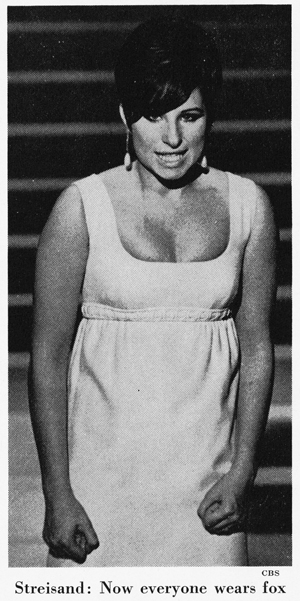Barbra
Newsweek, March 23, 1966

Barbra Streisand represents a triumph of aura over appearance. Her nose is too long, her bosom too small, her hips too wide. Yet when she steps in front of a microphone she transcends generations and cultures, appealing equally to the expense-account set and to kinetic teenagers whose horizons were previously limited to the Beatles. As soon as she became a superstar two years ago, her exotic, thrift-shop clothes became the thing to wear. Within months the full- throated Streisand singing style, “Streisand hair,” “Streisand hands,” and generally the “Streisand look” were emulated. It became “in” to look Jewish.
Today Barbra Streisand is 23 years old, rich, thoughtful, still nervous and somewhat annoyed by the burdens of stardom (“All that garbage,” she says). When she boarded Pan American’s flight 100 last week to begin rehearsals for the London run of “Funny Girl,” she was accompanied by her dresser, her secretary, her manager and his wife. A four-man BBC crew was sent to accompany her on the plane and to prepare a “Barbra Streisand Arrives” special. Her husband, actor-producer Elliott Gould, had already gone to London to search out suitable digs.
Two years ago, in her Broadway debut as Miss Marmelstein in “I Can Get It for You Wholesale,” she was paid $200 a week. By the end of her stint in “Funny Girl” last December, she was earning more than $5,000 a week. Her manager, Martin Erlichman, has had 600 requests for concerts—some offering as much as $50,000 a night—and has refused to let her play such locales as New York’s Shea Stadium and the Houston Astrodome. “As an artist,” he said, “it wouldn’t be right for her. All she’d make is money.” In January, she will begin the movie of “Funny Girl,” for which she may earn $1 million. She has made seven LP’s for Columbia Records, every one of them a $1 million-plus winner. And for doing ten CBS specials, she received a contract “in excess of $5 million.”
Tour de Force: Barbra Streisand’s first special dominated the Emmy Awards last year. Her second, called “Color Me Barbra,” will be shown next week (March 30, 9-10 p.m., EST). Dressed in exquisite clothes by Ray Diffen, she belts her way through ballads (“Too Long at the Fair”) in a circus sequence, bounces on a trampoline, singing, “I Love You,” and wanders moodily through the Philadelphia Museum of Art with “Where or When.” The show is a one-woman tour de force of song and sex appeal. Her contract calls for one more special this year, only one a year thereafter.
Before she left for London, where “Funny Girl” is already sold out for the three-month run, she sat with NEWSWEEK TV editor Peter Benchley in the living room of her duplex penthouse on New York’s Central Park West and told him: “I can’t say that people copied me, but two years ago I started wearing fox; now everybody I know wears fox.” With success, she found that she could express her tastes expensively, and last year discovered herself simultaneously being put down for outlandish clothes (a 1930s fur coat) and elected to the International Best Dressed List. This month, she is on the cover of Vogue. “Why do people feel they have to get you down to a label?” she said. “It’s easier to refer to Barbra Streisand the kook than Barbra Streisand the actress or singer. Yeah, well, I guess that was such a colorful time in my life. I guess the kookiness started as a fashion thing. Then the television show reached so many people. It was like a test—does she go beyond kookiness?” Her sponsor, Chemstrand, was so convinced she does that the company sent her to the Paris collections, where she picked out nine Diors, at an average cost of $2,000, to wear on her next show.
Success has not—outwardly, at least—changed her much. She has a passion for cold cucumber soup, but is also fond of the chocolate soufflé at “21.” When she worked as a cashier in a Chinese restaurant in Brooklyn, she picked up a few words of Chinese, and she loves to wander into Chinatown restaurants ordering items that aren’t on the menu. Her only experiment with pretension, a second-hand, cream-colored Bentley (“less obvious than a new Rolls”), exploded in a cloud of smoke in Central Park last month, and she now drives (badly) a Chrysler. “Basically, I find her more responsible,” said a close friend. “She is altogether nicer, more thoughtful, more concerned about everything. Yet she seems calmer, too.”
Home: The walls of her six-room apartment are hung with reminders of her sudden spurt to fame. Her seven gold records line the hallway leading to the den. Near the piano is some original Fanny Brice sheet music. And tucked away in a bookcase are signed photographs of Presidents Kennedy and Johnson. During the day, when she is not working, she putters around the apartment, discussing clothes with her designer, planning record covers, talking with friends, advisers, managers.
“Kids stand downstairs with cameras and ask if they can ride downtown with me,” she said. “And, like, I’m eating in a restaurant, spare ribs or something, and they stand there waiting for an autograph while you get a napkin and dry your fingers. Sometimes they come up and ask for it for their daughter, and I say, ‘Oh, you don’t like me, right?’ ”
In her work, Miss Streisand has become an unrelenting professional. At a recording session, she will offer suggestions about the sound of the drums and will often re-record a whole song because she is displeased with one note. She hates making decisions but insists on being a party to even the most minor changes in costume, sound or design. “I have 50 ways to do everything,” she said. “I love it when a director makes up my mind for me. I wish they would do it more often. I don’t know why they don’t. Maybe they’re afraid.” More likely, it is because she feels that only she can find the answer that is perfect for her.
Future: After the London run of “Funny Girl” ends in July, she will return, take a vacation, do some concerts, make another television show. She refuses to think any further ahead than January and the new picture. “Why should I?” she asked. “I’d like to do movies, maybe. I’d never do a TV series. Well, maybe later, but now—ugh!—no. It’s worse than doing a Broadway show. I don’t like to work that much. We taped for 40 hours for the eight-minute sequence in the museum. Maybe if I only did TV shows, or only records, it would be fun.” She sat back and rubbed Sadie, the toy French poodle given to her by the “Funny Girl” cast. “I’d like to do the least I can to be remembered.”
End.
